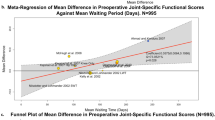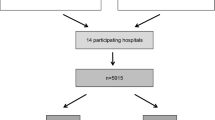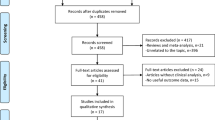Abstract
Background
Patients with end-stage single compartment osteoarthritis benefit from the less invasive unicompartmental knee arthroplasty (UKA). With increasing financial restraints, some healthcare services have set specific BMI cut-offs when determining patient eligibility for knee arthroplasty due to perceived obesity-related complications. The aim of this systematic review is to determine the effect obesity has on outcomes following UKA, and thus elucidate whether obesity should be a contraindication for UKA.
Methods
A PRISMA systematic review was conducted using five databases (MEDLINE, EMBASE, Cochrane, PubMed and Web of Science) to identify all clinical studies that examined the effect of obesity on outcomes following UKA. Quantitative meta-analysis was carried out using RevMan 5.3 software. Quality assessment was carried out using the Critical Appraisal Skills Programme (CASP) checklist.
Results
Thirty studies, including a total of 80 798 patients were analysed. The mean follow- up duration was 5.42 years. Subgroup meta-analyses showed no statistically significant difference following UKA between patients cohorts with and without obesity in overall complication rates (95% CI, P = 0.52), infection rates (95% CI, P = 0.81), and revision surgeries (95% CI, P = 0.06). When further analysing complications, no differences were identified in minor (95% CI, P = 0.23) and major complications (95% CI, P = 0.68), or venous thromboembolism rates (95% CI, P = 0.06). When further analysing revision surgeries, no differences were identified for revisions specifically for infection (95% CI, P = 0.71) or aseptic loosening (95% CI, P = 0.75).
Conclusions
This meta-analysis shows that obesity does not result in poorer post-operative outcomes following UKA and should not be considered a contraindication for UKA. Future studies, including long-term follow-up RCTs and registry-level analyses, should examine factors associated with obesity and consider stratifying obesity to better delineate any potential differences in outcomes.
This is a preview of subscription content, access via your institution
Access options
Subscribe to this journal
Receive 12 print issues and online access
$259.00 per year
only $21.58 per issue
Buy this article
- Purchase on Springer Link
- Instant access to full article PDF
Prices may be subject to local taxes which are calculated during checkout



Similar content being viewed by others
References
Hruby A, Hu FB. The epidemiology of obesity: a big picture. Vol. 33, PharmacoEconomics. Springer International Publishing; 2015. p. 673–89.
Welborn TA, Knuiman MW, Vu HTV. Body mass index and alternative indices of obesity in relation to height, triceps skinfold and subsequent mortality: the Busselton health study. Int J Obes. 2000;24:108–15.
World Health Organisation. Obesity and overweight [Internet]. https://www.who.int/news-room/fact-sheets/detail/obesity-and-overweight. Accessed 5 May 2020.
Kelly T, Yang W, Chen CS, Reynolds K, He J. Global burden of obesity in 2005 and projections to 2030. Int J Obes. 2008;32:1431–7.
Coggon D, Reading I, Croft P, McLaren M, Barrett D, Cooper C. Knee osteoarthritis and obesity. Int J Obes. 2001;25:622–7.
Grotle M, Hagen KB, Natvig B, Dahl FA, Kvien TK. Obesity and osteoarthritis in knee, hip and/or hand: an epidemiological study in the general population with 10 years follow-up. BMC Musculoskelet Disord. 2008;9:132.
Zheng H, Chen C. Body mass index and risk of knee osteoarthritis: systematic review and meta-analysis of prospective studies. Vol. 5, BMJ Open. BMJ Publishing Group; 2015.
Reyes C, Leyland KM, Peat G, Cooper C, Arden NK, Prieto-Alhambra D. Association between overweight and obesity and risk of clinically diagnosed knee, hip, and hand osteoarthritis: a population-based cohort study. Arthritis Rheumatol. 2016;68:1869–75.
Cross M, Smith E, Hoy D, Nolte S, Ackerman I, Fransen M, et al. The global burden of hip and knee osteoarthritis: estimates from the global burden of disease 2010 study. Ann Rheum Dis. 2014;73:1323–30. http://www.ncbi.nlm.nih.gov/pubmed/24553908. Accessed 20 July 2019.
Sen R, Hurley JA. Osteoarthritis. StatPearls. StatPearls Publishing; 2020. http://www.ncbi.nlm.nih.gov/pubmed/29493951. Accessed 3 June 2020.
Schwab PE, Lavand’homme P, Yombi JC, Thienpont E. Lower blood loss after unicompartmental than total knee arthroplasty. Knee Surgery. Sport Traumatol Arthrosc. 2015;23:3494–500.
Tabor OB, Tabor OB. Unicompartmental arthroplasty: a long-term follow-up study. J Arthroplasty. 1998;13:373–9.
Brown NM, Sheth NP, Davis K, Berend ME, Lombardi AV, Berend KR, et al. Total knee arthroplasty has higher postoperative morbidity than unicompartmental knee arthroplasty: a multicenter analysis. J Arthroplasty. 2012;27:S86–S90. 1(8 SUPPL.)
Liddle AD, Judge A, Pandit H, Murray DW. Adverse outcomes after total and unicompartmental knee replacement in 101330 matched patients: a study of data from the National Joint Registry for England and Wales. Lancet. 2014;384:1437–45.
Hunt LP, Ben-Shlomo Y, Clark EM, Dieppe P, Judge A, Macgregor AJ, et al. 45-day mortality after 467779 knee replacements for osteoarthritis from the National Joint Registry for England and Wales: an observational study. Lancet. 2014;384:1429–36.
Chawla H, van der List JP, Christ AB, Sobrero MR, Zuiderbaan HA, Pearle AD. Annual revision rates of partial versus total knee arthroplasty: a comparative meta-analysis. Knee. 2017;24:179–90.
Kandil A, Werner BC, Gwathmey WF, Browne JAObesity. Morbid obesity and their related medical comorbidities are associated with increased complications and revision rates after unicompartmental knee arthroplasty. J Arthroplasty. 2015;30:456–60.
Jeschke E, Gehrke T, Günster C, Hassenpflug J, Malzahn J, Niethard FU. et al. Five-year survival of 20,946 unicondylar knee replacements and patient risk factors for failure. J Bone Jt Surg. 2016;98:1691–8. http://journals.lww.com/00004623-201610190-00002.
Berend KR, Lombardi A V., Mallory TH, Adams JB, Groseth KL. Early failure of minimally invasive unicompartmental knee arthroplasty is associated with obesity. In: Clin Orthop Relat Res. 2005. p. 60–6.
Cavaignac E, Lafontan V, Reina N, Pailhé R, Warmy M, Laffosse JM. et al. Obesity has no adverse effect on the outcome of unicompartmental knee replacement at a minimum follow-up of seven years. Bone Joint J. 2013;95-B:1064–8. http://online.boneandjoint.org.uk/doi/10.1302/0301-620X.95B8.31370.
Plate JF, Augart MA, Seyler TM, Bracey DN, Hoggard A, Akbar M, et al. Obesity has no effect on outcomes following unicompartmental knee arthroplasty. Knee Surg Sports Traumatol Arthrosc. 2017;25:645–51. http://ovidsp.ovid.com/ovidweb.cgi?T=JS&PAGE=reference&D=med13&NEWS=N&AN=25863681.
Alvi HM, Mednick RE, Krishnan V, Kwasny MJ, Beal MD, Manning DW. The Effect of BMI on 30 day outcomes following total joint arthroplasty. J Arthroplasty. 2015;30:1113–7.
Memtsoudis SG, Besculides MC, Gaber L, Liu S, González Della Valle A. Risk factors for pulmonary embolism after hip and knee arthroplasty: a population-based study. Int Orthop. 2009;33:1739–45.
Namba RS, Inacio MCS, Paxton EW. Risk factors associated with deep surgical site infections after primary total knee arthroplasty: an analysis of 56,216 knees. J Bone Jt Surg—Ser A. 2013;95:775–82.
Preferred Reporting Items for Systematic Reviews and Meta-Analyses (PRISMA). 2015. http://www.prisma-statement.org/. Accessed 20 July 2019.
O’Connor D, Green S HJ. Defining the review question and developing criteria for including studies. In: Cochrane handbook for systematic reviews of interventions: Cochrane book series. 2008. https://training.cochrane.org/handbook. Accessed 20 July 2019.
Lefebvre C, Manheimer E, Glanville J. Searching for studies. In: Cochrane handbook for systematic reviews of interventions. John Wiley and Sons; 2008. p. 95–150. (Cochrane Handbook for Systematic Reviews of Interventions: Cochrane Book Series). https://doi.org/10.1002/9780470712184.ch6.
Morrison A, Polisena J, Husereau D, Moulton K, Clark M, Fiander M, et al. The effect of English-language restriction on systematic review-based meta-analyses: a systematic review of empirical studies. Int J Technol Assess Health Care. 2012;28:138–44. http://www.ncbi.nlm.nih.gov/pubmed/22559755. Accessed 18 Jul 2019.
Critical Appraisal Skills Programme. CASP cohort study checklist. 2018. https://casp-uk.net/wp-content/uploads/2018/01/CASP-Cohort-Study-Checklist_2018.pdf.
Nettrour JF, Ellis RT, Hansen BJ, Keeney JA. High failure rates for unicompartmental knee arthroplasty in morbidly obese patients: a two-year minimum follow-up study. J Arthroplasty. 2020;35:989–96.
Polat AE, Polat B, Gürplnar T, Çarkçl E, Güler O. The effect of morbid obesity (BMI ≥ 35 kg/m2) on functional outcome and complication rate following unicompartmental knee arthroplasty: a case-control study. J Orthop Surg Res. 2019;14:266. Published 2019 Aug 22. https://doi.org/10.1186/s13018-019-1316-5.
Venkatesh H, Maheswaran S. Age and body mass index has no adverse effect on clinical outcome of unicompartmental knee replacement-midterm followup study. Indian J Orthop. 2019;53:442–5.
Sundaram K, Warren J, Anis H, George J, Murray T, Higuera CA, et al. An increased body mass index was not associated with higher rates of 30-day postoperative complications after unicompartmental knee arthroplasty. Knee. 2019;26:720–8.
Affatato S, Caputo D, Bordini B. Does the body mass index influence the long-term survival of unicompartmental knee prostheses? A retrospective multi-centre study. Int Orthop. 2019;43:1365–70.
Scott CEH, Wade FA, MacDonald D, Nutton RW. Ten-year survival and patient-reported outcomes of a medial unicompartmental knee arthroplasty incorporating an all-polyethylene tibial component. Arch Orthop Trauma Surg. 2018;138:719–29.
Woo YL, Chen YQJ, Lai MC, Tay KJD, Chia SL, Lo NN, et al. Does obesity influence early outcome of fixed-bearing unicompartmental knee arthroplasty? J Orthop Surg. 2017;25:2309499016684297. https://doi.org/10.1177/2309499016684297. PMID: 28366049.
Murray DW, Pandit H, Weston-Simons JS, Jenkins C, Gill HS, Lombardi AV, et al. Does body mass index affect the outcome of unicompartmental knee replacement? Knee. 2013;20:461–5.
Xu S, Lim WAJ, Chen JY, Lo NN, Chia SL, Tay DKJ, et al. The influence of obesity on clinical outcomes of fixed-bearing unicompartmental knee arthroplasty: a ten-year follow-up study. Bone Jt J. 2019;101B:213–20.
Molloy J, Kennedy J, Jenkins C, Mellon S, Dodd C, Murray D. Obesity should not be considered a contraindication to medial Oxford UKA: long-term patient-reported outcomes and implant survival in 1000 knees. Knee Surg Sport Traumatol Arthrosc. 2019;27:2259–65.
Zengerink I, Duivenvoorden T, Niesten D, Verburg H, Bloem R, Mathijssen N. Obesity does not influence the outcome after unicompartmental knee arthroplasty. Acta Orthopaedica Belgica. 2015;81:776–83.
Çepni SK, Arslan A, Polat H, Yalçin A, Parmaksizoǧlu AS. Mid-term results of oxford phase 3 unicompartmental knee arthroplasty in obese patients. Acta Orthop Traumatol Turc. 2014;48:122–6.
Bonutti PM, Goddard MS, Zywiel MG, Khanuja HS, Johnson AJ, Mont MA. Outcomes of unicompartmental knee arthroplasty stratified by body mass index. J Arthroplasty. 2011;26:1149–53. http://www.ncbi.nlm.nih.gov/pubmed/21256695.
National Joint Registry. Proceedings of 16th Annual Report 2019. 2019. www.njrreports.org.uk. Accessed 23 May 2020.
Han SB, Kyung HS, Seo IW, Shin YS. Better clinical outcomes after unicompartmental knee arthroplasty when comparing with high tibial osteotomy. Medicine. 2017:96.
Winnock de Grave P, Barbier J, Luyckx T, Ryckaert A, Gunst P, Van, et al. Outcomes of a fixed-bearing, medial, cemented unicondylar knee arthroplasty design: survival analysis and functional score of 460 cases. J Arthroplasty. 2018;33:2792–9.
Wilson HA, Middleton R, Abram SGF, Smith S, Alvand A, Jackson WF, et al. Patient relevant outcomes of unicompartmental versus total knee replacement: systematic review and meta-analysis. BMJ. 2019:364.
Walker T, Hetto P, Bruckner T, Gotterbarm T, Merle C, Panzram B, et al. Minimally invasive Oxford unicompartmental knee arthroplasty ensures excellent functional outcome and high survivorship in the long term. Knee Surg Sport Traumatol Arthrosc. 2019;27:1658–64.
National population projections—Office for National Statistics. https://www.ons.gov.uk/peoplepopulationandcommunity/populationandmigration/populationprojections/bulletins/nationalpopulationprojections/2018based. Accessed 20 May 2020.
Ageing | United Nations. https://www.un.org/en/sections/issues-depth/ageing/. Accessed 20 May 2020.
Sowers MR, Karvonen-Gutierrez CA. The evolving role of obesity in knee osteoarthritis. Curr Opin Rheumatol. 2010;22:533–7.
Seth A, Dobransky J, Albishi W, Dervin GF. Mid-term evaluation of the unicompartmental knee arthroplasty in patients with BMI of 40 or greater. J Knee Surg. 2019:10. https://doi.org/10.1055/s-0039-1696735. Epub ahead of print. PMID: 31505699.
Niinimäki TT, Murray DW, Partanen J, Pajala A, Leppilahti JI. Unicompartmental knee arthroplasties implanted for osteoarthritis with partial loss of joint space have high re-operation rates. Knee. 2011;18:432–5.
Kuipers BM, Kollen BJ, Kaijser Bots PC, Burger BJ, van Raay JJAM, Tulp NJA, et al. Factors associated with reduced early survival in the Oxford phase III medial unicompartment knee replacement. Knee. 2010;17:48–52.
Naal FD, Neuerburg C, Salzmann GM, Kriner M, Knoch F, Preiss S, et al. Association of body mass index and clinical outcome 2 years after unicompartmental knee arthroplasty. Arch Orthop Trauma Surg. 2009;129:463–8.
Liddle AD, Pandit H, Judge A, Murray DW. Optimal usage of unicompartmental knee arthroplasty: a study of 41 986 cases from the national joint registry for England and Wales. Bone Jt J. 2015;97B:1506–11.
Emerson RH, Alnachoukati O, Barrington J, Ennin K. The results of Oxford unicompartmental knee arthroplasty in the United States: a mean ten-year survival analysis. Bone Jt J. 2016;98-B:34–40.
Pandit H, Jenkins C, Gill HS, Smith G, Price AJ, Dodd CAF, et al. Unnecessary contraindications for mobile-bearing unicompartmental knee replacement. J Bone Jt Surg—Ser B. 2011;93 B:622–8.
Xing Z, Katz J, Jiranek W. Unicompartmental knee arthroplasty: factors influencing the outcome. J Knee Surg. 2012;25:369–73.
Haughom BD, Schairer WW, Hellman MD, Nwachukwu BU, Levine BR. An analysis of risk factors for short-term complication rates and increased length of stay following unicompartmental knee arthroplasty. HSS J. 2015;11:112–6.
Kort NP, Van Raay JJAM Van, Horn JJ. The Oxford phase III unicompartmental knee replacement in patients less than 60 years of age. Knee Surgery. Sport Traumatol Arthrosc. 2007;15:356–60.
Sephton BM, Bakhshayesh P, Edwards TC, Ali A, Kumar Singh V, Nathwani D. Predictors of extended length of stay after unicompartmental knee arthroplasty. J Clin Orthop Trauma. 2020;11:S239–45.
Uzun E, Misir A, Kizkapan TB, Ozcamdalli M, Gunay AE, Husrevoglu K. Mid-term functional, clinical, and radiological outcomes with factors affecting revision of mobile-bearing medial unicompartmental knee arthroplasty. Knee. 2020;27:527–34.
Giori NJ, Amanatullah DF, Gupta S, Bowe T, Harris AHS. Risk reduction compared with access to care: quantifying the trade-off of enforcing a body mass index eligibility criterion for joint replacement. J Bone Joint Surg—American Volume. 2018;100:539–45. Lippincott Williams and Wilkins.
Adhikary SD, Liu WM, Memtsoudis SG, Davis CM, Liu J. Body mass index more than 45 kg/m2 as a cutoff point is associated with dramatically increased postoperative complications in total knee arthroplasty and total hip arthroplasty. J Arthroplasty. 2016;31:749–53.
Goodfellow J, O’connor J, Dodd C, Murray D. Unicompartmental Arthroplasty with the Oxford Knee 2nd edition. Oxford: Goodfellow Publishers. 2015:1–192. https://doi.org/10.23912/978-1-910158-45-6-1517.
Bini S, Khatod M, Cafri G, Chen Y, Paxton EW. Surgeon, implant, and patient variables may explain variability in early revision rates reported for unicompartmental arthroplasty. J Bone Jt Surg—Ser A. 2013;95:2195–202. https://pubmed.ncbi.nlm.nih.gov/24352773/.
Cossey AJ, Spriggins AJ. The use of computer-assisted surgical navigation to prevent malalignment in unicompartmental knee arthroplasty. J Arthroplasty. 2005;20:29–34. https://pubmed.ncbi.nlm.nih.gov/15660057/.
Suero EM, Citak M, Njoku IU, Pearle AD. Does the type of tibial component affect mechanical alignment in unicompartmental knee replacement? Technol Health Care. 2013;21:81–5. https://pubmed.ncbi.nlm.nih.gov/23361217/. Accessed 29 Aug 2020.
Agarwal N, To K, McDonnell S, Khan W. Clinical and radiological outcomes in robotic-assisted total knee arthroplasty: a systematic review and meta-analysis. J Arthroplasty. 2020;35:3393–3409.e2. https://doi.org/10.1016/j.arth.2020.03.005.
Kozinn S, Scott R. Unicondylar knee arthroplasty. J Bone Jt Surg. 1989;71:145–50.
Simpson DJ, Price AJ, Gulati A, Murray DW, Gill HS. Elevated proximal tibial strains following unicompartmental knee replacement—a possible cause of pain. Med Eng Phys. 2009;31:752–7. https://pubmed.ncbi.nlm.nih.gov/19278893/.
Small SR, Berend ME, Ritter MA, Buckley CA, Rogge RD. Metal backing significantly decreases tibial strains in a medial unicompartmental knee arthroplasty model. J Arthroplasty. 2011;26:777–82. https://pubmed.ncbi.nlm.nih.gov/20870385/.
NHLBI Obesity Education Initiative Expert Panel on the Identification E and T of O in A (US). Clinical guidelines on the identification, evaluation, and treatment of overweight and obesity in adults. 1998. https://www.ncbi.nlm.nih.gov/books/NBK2003/. Accessed 29 Aug 2020.
Guh DP, Zhang W, Bansback N, Amarsi Z, Birmingham CL, Anis AH. The incidence of co-morbidities related to obesity and overweight: a systematic review and meta-analysis. BMC Public Health. 2009;9:88. http://bmcpublichealth.biomedcentral.com/articles/10.1186/1471-2458-9-88.
Haslam DW, James WPT. Obesity. In: Lancet. 2005. p. 1197–209. https://pubmed.ncbi.nlm.nih.gov/16198769/. Accessed 29 Aug 2020.
Walls JD, Abraham D, Nelson CL, Kamath AF, Elkassabany NM, Liu J. Hypoalbuminemia more than morbid obesity is an independent predictor of complications after total hip arthroplasty. J Arthroplasty. 2015;30:2290–5.
Nelson CL, Elkassabany NM, Kamath AF, Liu J. Low albumin levels, more than morbid obesity, are associated with complications after TKA. Clin Orthop Relat Res. 2015;473:3163–72.
Sloan M, Sheth NP, Nelson CL. Obesity and hypoalbuminaemia are independent risk factors for readmission and reoperation following primary total knee arthroplasty. Bone Joint J. 2020;102-B:31–5.
Author information
Authors and Affiliations
Corresponding author
Ethics declarations
Conflict of interest
The authors declare that they have no conflict of interest.
Additional information
Publisher’s note Springer Nature remains neutral with regard to jurisdictional claims in published maps and institutional affiliations.
Supplementary information
Rights and permissions
About this article
Cite this article
Agarwal, N., To, K., Zhang, B. et al. Obesity does not adversely impact the outcome of unicompartmental knee arthroplasty for osteoarthritis: a meta-analysis of 80,798 subjects. Int J Obes 45, 715–724 (2021). https://doi.org/10.1038/s41366-020-00718-w
Received:
Revised:
Accepted:
Published:
Issue Date:
DOI: https://doi.org/10.1038/s41366-020-00718-w
This article is cited by
-
Obesity increases the risk of conversion to total knee arthroplasty after unicompartimental knee arthroplasty: a meta-analysis
Knee Surgery, Sports Traumatology, Arthroscopy (2022)
-
Patients lose weight after a total knee arthroplasty: myth or reality?
International Orthopaedics (2022)
-
Obesity does not adversely impact the outcome of unicompartmental knee arthroplasty for osteoarthritis: a meta-analysis of 80,798 subjects
International Journal of Obesity (2021)



